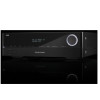Harman Kardon AVR 1710 Owners Manual - Page 43
Channel Stereo
 |
View all Harman Kardon AVR 1710 manuals
Add to My Manuals
Save this manual to your list of manuals |
Page 43 highlights
English AVR Appendix Table A10 - Surround Modes - continued Surround Mode DTS Neo:6 Mode Group Description DTS Neo:6 analog processing is available with DTS and DTS 96/24 signals and two-channel analog or PCM signals to create a 3-, 5- or 6-channel presentation. Incoming Bitstream or Signal See below DTS Neo:6 Cinema DTS Neo:6 Music HARMAN NSP 5-Channel Stereo 7-Channel Stereo (AVR 1710/ AVR 171 only) 2-Channel Stereo Depending on the number of speakers in your system, select 3-, 5- or 6-channel modes, enhanced for movie or video presentations. • DTS 2/2/.0 or .1, 3/2/.0 or .1 • DTS 96/24 • Analog (two-channel) • PCM (32kHz, 44.1kHz or 48kHz) Available only in 5- and 6-channel modes, creates a surround presentation suitable for music recordings. • DTS 2/2/.0 or .1, 3/2/.0 or .1 • DTS 96/24 • Analog (two-channel) • PCM (32kHz, 44.1kHz or 48kHz) A HARMAN proprietary technology, NSP uses sophisticated digital processing to deliver • Analog (two-channel) a true natural sounding three-dimensional listening experience from conventional 2-channel stereo sources like CDs and stereo broadcasts. While preserving the recording's original timbre and spatial balance, HARMAN NSP creates a simulated • Tuner • PCM (32kHz, 44.1kHz, 48kHz, 96kHz) listening space that automatically adjusts to suit the type of program you are listening to. Adjustments are available for the size of the simulated space and for how aggressively NSP automatically adjusts the simulated space to compliment the program material. Useful for parties, the left- and right-channel information is played through both • Analog (two-channel) the front and surround speakers on each side, while the center speaker plays a summed mono mix. • Tuner • PCM (32kHz, 44.1kHz, 48kHz, 96kHz) Expands the 5-Channel Stereo presentation to include the surround back channels. • Analog (two-channel) • Tuner • PCM (32kHz, 44.1kHz, 48kHz, 96kHz) Turns off all surround processing and plays a pure two-channel signal or a downmix of a multichannel signal. The signal is digitized and bass management settings are applied, making it appropriate when a subwoofer is used. • Analog (two-channel; DSP downmix available for multichannel) • Tuner • PCM (32kHz, 44.1kHz, 48kHz, 96kHz) 43















